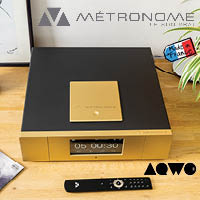Vincent Audio SV-228 Hybrid Integrated Amplifier
Vincent Audio is one of those stalwart brands whose products tend to be classically styled, well reviewed and reasonably priced. Yet Vincent gets nowhere near the amount of coverage as some trendy niche brands in high-end audio. Who knows why that is, but wouldn’t it be wonderful if they just spent their marketing budget on engineering? In any case, it’s been my pleasure to spend several weeks with Vincent’s new SV-228 Hybrid Integrated Amplifier to give it a proper listen and share my impressions.
The SV-228 retails for $2499, putting it right in the middle of the fierce market for amplifiers. I’ve reviewed a handful of excellent amps in my couple of years with Audiophilia and all were in the $2000-3000 range. Still, despite its traditional looks, the SV-228 manages to be a sonic outlier. Let’s dive into the product and then explore its performance.
Features & Specs
The SV-228 replaces the outgoing SV-227MK. New features include an updated DAC with Bluetooth and (hallelujah!) VU meters. The interior layout has been totally redone as well. The topology of the SV-228, like many Vincent integrated amplifiers, consists of a tube preamplifier section feeding a Class A/B power section. The preamplifier relies on one 6N4 and two ECC82 tubes, both affordable and widely available. These are interchangeable with 12AX7 and 12AU7 tubes respectively. There are numerous tube hybrid amps out on the market but most in the real-world price realm utilize Class D power modules with a tube preamp or output buffer. It’s cool to see the traditional circuit styles married here.
In terms of features, the SV–228 is a slight variation on the standard integrated amplifier formula. Here the phono stage is swapped for a DAC with Bluetooth connectivity. There are plenty of RCA line inputs and for digital, one coaxial and one optical input. Thankfully this integrated includes both pre-outs for the subwoofer crowd and record outputs for outboard headphone amps. A few years ago the absence of a USB input would be an issue but with the current streaming landscape that’s no longer a disadvantage.
The SV-228 features a 6.3 mm headphone output but it's unclear from simply popping the hood whether the headphone output just steps down the main circuit or if there is a dedicated op amp-based headphone stage.
Lastly, a basic but classy metal-clad remote is included.
Frequency Response: 20 Hz – 20 kHz (+/- 0.5 dB); 20 Hz – 50 kHz (+/- 2 dB)
Nominal Output Power RMS / 8 Ohm: 2 x 100 Watt
Nominal Output Power RMS / 4 Ohm: 2 x 180 Watt
Total Harmonic Distortion: < 0.1 % (1 kHz, 1 W)
Input Sensitivity: 560 mV
Signal to Noise Ratio: > 90 dB
Input Impedance: 47 kOhm
Max. Power Consumption: 350 Watt
Inputs: 2 x Stereo RCA, 1 x Coaxial, 1 x Optical, 1 x Bluetooth, 1 x Stereo Main In
Outputs: 1 x Stereo Pre Out, 1 x Stereo Rec Out, 4 x 2 Speaker Terminals
Tubes: 1 x 6N4, 2 x ECC82
Playable Digital Formats: WAV, FLAC, APE, LPCM, MP3, AAC, AC3, WMA
Colour: Black, Silver
Weight: 15.5 kg
Dimensions (W x H x D): 430 x 152 x 450 mm
Design & Build
The design of the SV-228 ($2499) comes as close as any product I’ve used to the platonic ideal of a “HiFi amplifier.” If I asked pedestrians on the street to sketch me a stereo amplifier I bet they’d come up with something like the Vincent. I mean that in the best way—it’s a classic. While it does vaguely resemble some Japanese amplifiers, it doesn’t seem derivative up close. Besides, no one has a monopoly on a classic design. I can’t think of any other manufacturers offering tube-class A/B hybrid amps with VU meters.
As far as the construction, the SV-228 is robustly assembled with familiar-looking materials and techniques. The faceplate is thick anodized aluminum with precise silkscreened text. Most of the hefty mass of the SV-228 can obviously be attributed to an enormous toroidal transformer, located in the back left corner of the unit.
Knob feel, as one would hope for such an attractive piece, is excellent. The volume control is based on a proven motorized Alps potentiometer. I found it to have a nice smooth resistance, linear ramp-up, and no noticeable channel imbalance at low volumes. There is a widely usable sweet spot between 10 and 1 o’clock.
Daily Use & Setup
The setup of the SV-228 is as simple as can be—just plug and play. That includes the Bluetooth input. My five-year-old phone recognized the SV-228 every time without a hitch. My review unit had some mileage on it so I didn’t put too much effort into the initial break-in. I can say, however, that it consistently takes a couple of songs for the tubes to warm up and the sound to reach its peak fullness. The tubes have plenty of space around them inside the chassis but the top still gets warm to the touch. Placement with a bit of breathing room would be wise.
Review System
While I did plenty of listening with my standard Project Debut Carbon/2M Red /iFi Zen Phono front end, most of my critical listening was in the digital realm for consistency throughout the evaluation. This meant either streaming from my Wiim Mini via optical or spinning CDs on my Yamaha universal player via coaxial. Electronics on reference duty were the Cambridge Audio EVO 150 and Ferrum ERCO DAC/Headphone Amp. Speakers used were the detailed yet reliably neutral PSB Synchrony B600 and the Wharfedale Diamond 10.2 for a more warm and cozy alternative. Headphones included the Massdrop x Sennheiser HD6XX and Sendy Audio Peacock.
Available in black, too.
Listening
I’ll cut to the chase here and declare the Vincent SV-228 has “a sound.” I did not experience the proverbial straight line with gain. This absolutely should not turn off any prospective audiophiles. That’s because the sound of the SV-228 is eminently engaging and easy to love.
Let’s start at the bottom, so to speak, with the low-end performance of the SV-228. I was on a rap kick while I had the SV-228 in-house. We all know the ’90s were the golden age of rap. The loudness wars that ruined many rock records during the peak CD era did not seem to affect some of my favourite rap albums. Bone Thugs-N-Harmony’s E. 1999 Eternal (Ruthless Records, 1995) is a stone-cold classic slice of Cleveland, Ohio culture. This wasn’t even supposed to be a demo album for this review but listening sessions with the Vincent were so illuminating that E. 1999 Eternal ended up in heavy rotation.
Blazing-fast verses and catchy harmonies over gangsta rap synths were perfectly spread out in my room. Vocals were firmly placed in three dimensions. All this is on top of an immense foundation of hard-hitting bass lines. I couldn’t believe the physicality of the low frequencies coming from the PSB B600. I remarked in my recent review of those speakers that their bass response was impressive. After extensive gear swapping I determined the speakers are indeed quite neutral and that the SV-228 was responsible for squeezing every ounce of bass out of them. Never was the presentation out of balance. With most music, the effect ended up being a slightly warm tonal balance.
To my ear, some classic Wagner orchestral music has the most dramatic effect when played with total abandon, the performances bordering on unhinged. Still, Wagner’s music is so complex (to me anyway) that the incredibly clean, precise playing of George Szell’s Cleveland Orchestra is still hair-raising. “Siegfried’s Funeral Music” on Great Orchestral Highlights From the Ring of the Nibelungs (Columbia, 1973) beautifully balanced lyrical nostalgia with menacing crescendos. The SV-228 handled the dynamics with perfect ease—no edginess or disruption to the enormous soundstage. The richness of tone only enhanced this emotional rollercoaster of a passage.
The SV-228 looks like it knows how to rock out and when fed some stripped-down blues it delivers. The Black Keys Chulahoma (Fat Possum Records, 2006) is a basic recording with fuzzy guitar and slightly hot vocals but Vincent delivered a full-bodied presentation without washing the grit and soul out of it. It never sounded overly romantic yet nevertheless seemed to flatter this recording. It’s reassuring that the SV-228 does as well here as with “audiophile” material.
Since moving my reference system into my office, I do a lot of casual daytime headphone listening while I work. Often this is just for background, but with the SV-228 I was consistently impressed at just how well the headphone section performed. With the easygoing Sendy Peacock planar magnetic headphones I got detailed, spacious and tonally satisfying sound regardless of musical genre. The 300-ohm Sennheiser HD6XX absolutely lit up when driven by the Vincent. The HD6XX can sound pretty sad when driven by an underpowered or otherwise mismatched amplifier. Here though it was pure synergy. The reality is not all integrated amps in this price range have excellent headphone stages. Inserting a Vincent SV-228 into a complete system should take care of headphone amplification for all but the hardcore headphones listeners.
The SV-228 demonstrated excellent control, and dominance even, over the speakers I paired with it. While it is quiet and has beautiful tonal qualities—great for sensitive speakers—I expect users will gravitate toward speakers that benefit from the substantial power on tap. The PSB Synchrony B600 was a spectacular match. The detailed highs and deep bass response seemed to allow them to take advantage of all the torque the Vincent could provide. Great imaging ability captured the holographic tube magic well. In general look for something with a sparkling top end that also loves current. Something along the lines of a Focal Aria K2 936 which I reviewed last year would certainly be an exciting match to try. Based on my impressions of my Wharfedale Diamond 10.2, warm-leaning speakers could be too much of a good thing here.
The more expensive an audio component the more tenuous the value proposition can become. Law of diminishing returns and all that. The SV-228 is a piece that can be evaluated by considering the sum of its parts. What would it take to assemble a tube preamplifier, a 100-watt Class A/B power amplifier, DAC, headphone amp and necessary cables? Anything close to the $2499 list price of the SV-228? Maybe for the most shrewd eBayers out there. But what about component synergy? And domestic dealer support and warranty? Oh yeah, and VU meters! In addition to its sound, the SV-228 is a compelling package when examined from a purely pragmatic perspective.
Conclusion
Looking for a classically styled, muscular amp with a bit of digital convenience? Vincent SV-228 could be the ticket. Throw in some low-maintenance tube magic and that’s a lot of boxes checked before even giving it a listen. The rightness of tone and lush, holographic presentation seals the deal. Add an entry-level phono stage to connect your turntable and it's easy to make the Vincent the centrepiece of a full system—or the centrepiece of a living room for that matter. I’ve had great review gear come and go for a couple of years now and the Vincent SV-228 was a hard one to send back. Enthusiastically recommended.
Further information: Vincent Audio



























